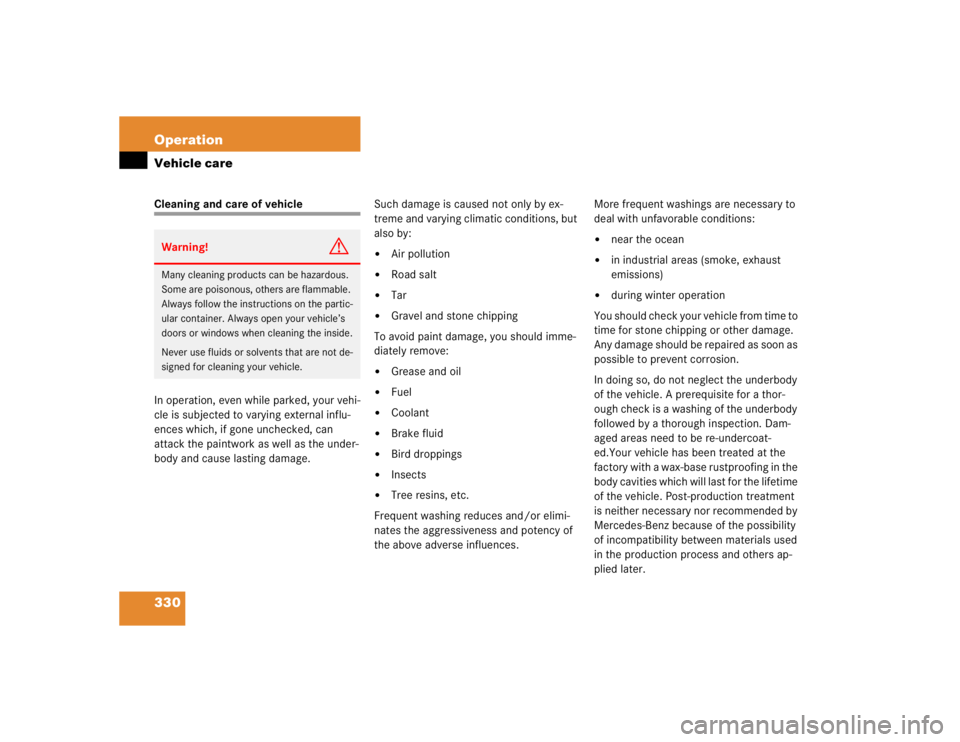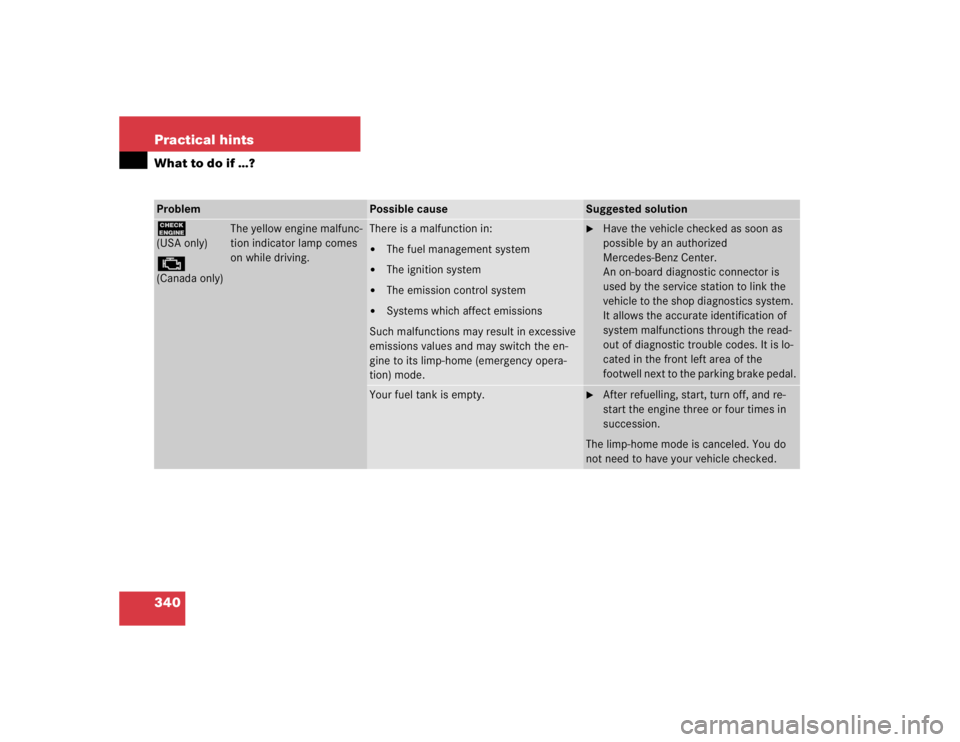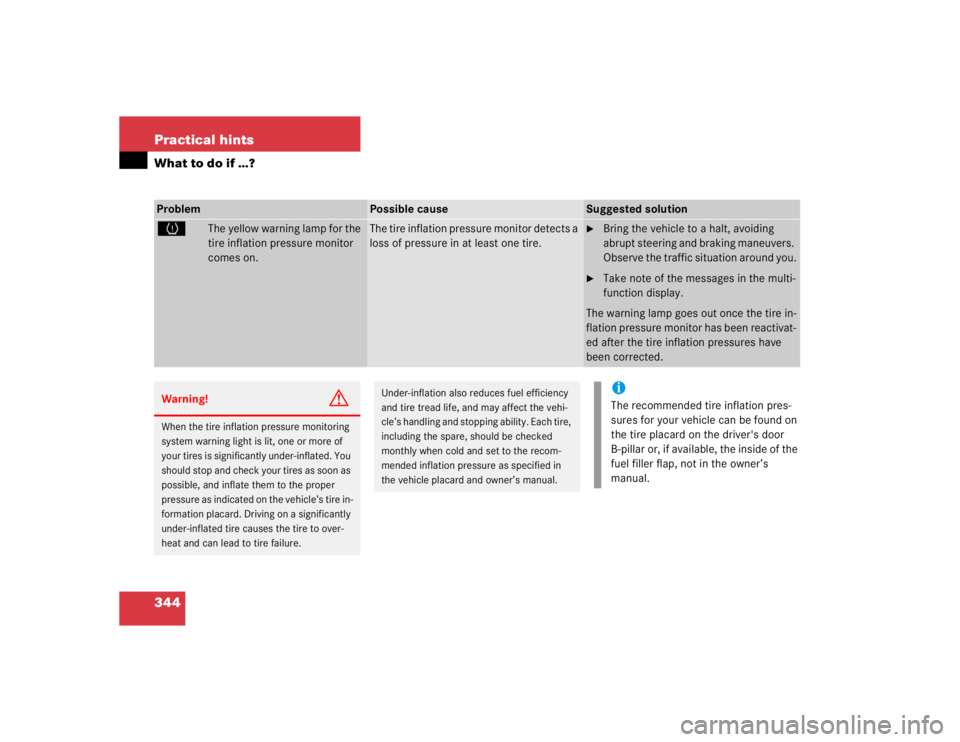Page 325 of 474

323 Operation
Tires and wheels
GVWR (G
ross V
ehicle W
eight R
ating)
This is the maximum permissible vehicle
weight of the fully loaded vehicle (weight of
the vehicle including all options, passen-
gers, fuel, and cargo and, if applicable,
trailer tongue load). It is indicated on
Certification label located on the driver's
door B-pillar.
Kilopascal (kPa)
The metric unit for air pressure. There are
6.9 kPa to one psi; another metric unit for
air pressure is bars. There are
100 kilopascals (kPa) to one bar.
Maximum load rating
The maximum load in kilograms and
pounds that can be carried by the tire.
Maximum loaded vehicle weight
The sum of curb weight, accessory weight,
vehicle capacity weight and production
options weight.Maximum tire inflation pressure
This number is the greatest amount of air
pressure that should ever be put in the tire
under normal driving conditions.
Normal occupant weight
The number of occupants the vehicle is
designed to seat, multiplied by
68 kilograms (150 lbs).
Occupant distribution
The distribution of occupants in a vehicle
at their designated seating positions.
Production options weight
The combined weight of those installed
regular production options weighing over
5 lbs (2.3 kilograms) in excess of those
standard items which they replace, not
previously considered in curb weight or
accessory weight, including heavy duty
brakes, ride levelers, roof rack, heavy duty
battery, and special trim.PSI (P
ounds per s
quare i
nch)
A standard unit of measure for air pressure
-> bar, kilopascal (kPa).
Recommended tire inflation pressure
Recommended tire inflation pressure
listed on placard located on driver's door
B-pillar for normal driving conditions.
Provides best handling, tread life and
riding comfort.
Rim
A metal support for a tire or a tire and tube
assembly upon which the tire beads are
seated.
Sidewall
The portion of a tire between the tread and
the bead.
Page 332 of 474

330 OperationVehicle careCleaning and care of vehicle
In operation, even while parked, your vehi-
cle is subjected to varying external influ-
ences which, if gone unchecked, can
attack the paintwork as well as the under-
body and cause lasting damage.Such damage is caused not only by ex-
treme and varying climatic conditions, but
also by:
�
Air pollution
�
Road salt
�
Tar
�
Gravel and stone chipping
To avoid paint damage, you should imme-
diately remove:
�
Grease and oil
�
Fuel
�
Coolant
�
Brake fluid
�
Bird droppings
�
Insects
�
Tree resins, etc.
Frequent washing reduces and/or elimi-
nates the aggressiveness and potency of
the above adverse influences.More frequent washings are necessary to
deal with unfavorable conditions:
�
near the ocean
�
in industrial areas (smoke, exhaust
emissions)
�
during winter operation
You should check your vehicle from time to
time for stone chipping or other damage.
Any damage should be repaired as soon as
possible to prevent corrosion.
In doing so, do not neglect the underbody
of the vehicle. A prerequisite for a thor-
ough check is a washing of the underbody
followed by a thorough inspection. Dam-
aged areas need to be re-undercoat-
ed.Your vehicle has been treated at the
factory with a wax-base rustproofing in the
body cavities which will last for the lifetime
of the vehicle. Post-production treatment
is neither necessary nor recommended by
Mercedes-Benz because of the possibility
of incompatibility between materials used
in the production process and others ap-
plied later.
Warning!
G
Many cleaning products can be hazardous.
Some are poisonous, others are flammable.
Always follow the instructions on the partic-
ular container. Always open your vehicle’s
doors or windows when cleaning the inside.
Never use fluids or solvents that are not de-
signed for cleaning your vehicle.
Page 342 of 474

340 Practical hintsWhat to do if …?Problem
Possible cause
Suggested solution
?(USA only)±(Canada only)
The yellow engine malfunc-
tion indicator lamp comes
on while driving.
There is a malfunction in:�
The fuel management system
�
The ignition system
�
The emission control system
�
Systems which affect emissions
Such malfunctions may result in excessive
emissions values and may switch the en-
gine to its limp-home (emergency opera-
tion) mode.
�
Have the vehicle checked as soon as
possible by an authorized
Mercedes-Benz Center.
An on-board diagnostic connector is
used by the service station to link the
vehicle to the shop diagnostics system.
It allows the accurate identification of
system malfunctions through the read-
out of diagnostic trouble codes. It is lo-
cated in the front left area of the
footwell next to the parking brake pedal.
Your fuel tank is empty.
�
After refuelling, start, turn off, and re-
start the engine three or four times in
succession.
The limp-home mode is canceled. You do
not need to have your vehicle checked.
Page 343 of 474
341 Practical hints
What to do if …?
Problem
Possible cause
Suggested solution
?(USA only)±(Canada only)
The yellow engine malfunc-
tion indicator lamp comes
on while driving.
A loss of pressure has been detected in the
fuel system. The fuel cap may not be closed
properly or the fuel system may be leaky.
�
Check the fuel cap (
�page 283).
If it is not closed properly:
�
Close the fuel cap.
If it is closed properly:
�
Have the fuel system checked by an au-
thorized Mercedes-Benz Center.
The yellow fuel tank reserve warning lamp
comes on while driving.
The fuel level has gone below the reserve
mark.
�
Refuel at the next gas station
(�page 283).
Page 346 of 474

344 Practical hintsWhat to do if …?Problem
Possible cause
Suggested solution
H
The yellow warning lamp for the
tire inflation pressure monitor
comes on.
The tire inflation pressure monitor detects a
loss of pressure in at least one tire.
�
Bring the vehicle to a halt, avoiding
abrupt steering and braking maneuvers.
Observe the traffic situation around you.
�
Take note of the messages in the multi-
function display.
The warning lamp goes out once the tire in-
flation pressure monitor has been reactivat-
ed after the tire inflation pressures have
been corrected.
Warning!
G
When the tire inflation pressure monitoring
system warning light is lit, one or more of
your tires is significantly under-inflated. You
should stop and check your tires as soon as
possible, and inflate them to the proper
pressure as indicated on the vehicle’s tire in-
formation placard. Driving on a significantly
under-inflated tire causes the tire to over-
heat and can lead to tire failure.
Under-inflation also reduces fuel efficiency
and tire tread life, and may affect the vehi-
cle’s handling and stopping ability. Each tire,
including the spare, should be checked
monthly when cold and set to the recom-
mended inflation pressure as specified in
the vehicle placard and owner’s manual.
iThe recommended tire inflation pres-
sures for your vehicle can be found on
the tire placard on the driver's door
B-pillar or, if available, the inside of the
fuel filler flap, not in the owner’s
manual.
Page 360 of 474
358 Practical hintsWhat to do if …?Display
Possible cause
Possible solution
?
VISIT WORKSHOP
There may be a malfunction in the:�
Fuel injection system
�
Ignition system
�
Exhaust system
�
Fuel system
�
Visit an authorized Mercedes-Benz
Center as soon as possible.
B
COOLANT
CHECK LEVEL!
The coolant level is too low.
�
Add coolant (
�page 292).
�
If you have to add coolant frequently,
have the cooling system checked by an
authorized Mercedes-Benz Center.
Warning!
G
Do not spill antifreeze on hot engine parts.
Antifreeze contains ethylene glycol which
may burn if it comes into contact with hot
engine parts. You can be seriously burned.
!Do not ignore the low engine coolant
level warning. Extended driving with
the message and symbol displayed
may cause serious engine damage not
covered by the Mercedes-Benz Limited
Warranty.
Do not drive without a sufficient
amount of coolant in the cooling sys-
tem. The engine will overheat, causing
major engine damage.
Page 373 of 474
371 Practical hints
What to do if …?
Display
Possible cause
Possible solution
A
TANK OPEN!
CHECK FILLER CAP!
A loss of pressure has been detected in
the fuel system. The fuel cap may not be
closed properly or the fuel system may be
leaky.
�
Check the fuel cap (
�page 283).
If it is not closed properly:
�
Close the fuel cap.
If it is closed properly:
�
Have the fuel system checked by an au-
thorized Mercedes-Benz Center.
Ê
TRUNK OPEN
This message will appear whenever the
trunk lid is open.
�
Close the trunk lid.
W
WASHER FLUID
CHECK LEVEL!
The fluid level has dropped to about
1/3
of total reservoir capacity.�
Add washer fluid (
�page 295).
Page 387 of 474
385 Practical hints
Unlocking/locking in an emergency
Fuel filler flap
In case the central locking system does
not release the fuel filler flap, you can open
it manually.
1Release knob�
Open the trunk.
�
Remove the trim inside the trunk on the
right-hand side.
�
Pull release knob1 in the direction of
arrow.
The fuel filler flap can be opened.